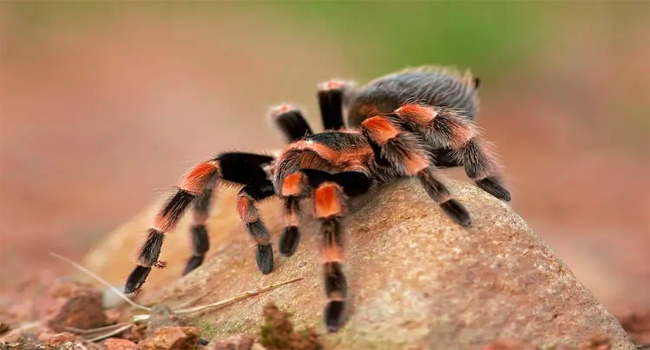Introduction
Tarantulas are lovely creatures that have captured the imagination of many with their exotic appearance and mysterious behavior. In this beginner’s guide, we will take you on a journey into the intriguing world of tarantulas, exploring their characteristics, habitat, care, and why these eight-legged wonders are a popular choice among arachnid enthusiasts.
What are Tarantulas?
Tarantulas are giant, hairy spiders from the Theraphosidae family, known for their striking appearance and impressive size. These arachnids can be found in various parts of the world, with diverse species showcasing unique characteristics.
The Diversity of Tarantulas
- Geographic Distribution
Tarantulas can be found on almost every continent except Antarctica. They thrive in regions ranging from tropical rainforests to arid deserts, and their distribution often depends on the species adaptability to specific environments.
- Species Variation
There are over 900 recognized tarantula species, each with distinct features, colors, and behaviors. Some popular species among enthusiasts include the Mexican Redknee Tarantula, the Brazilian Salmon Pink Bird-Eating Tarantula, and the Goliath Bird-Eating Tarantula.
- Size Matters
One of the most intriguing aspects of tarantulas is their size. These spiders come in various sizes, some measuring just a few inches, while others can have leg spans of up to 12 inches. This diversity makes tarantulas a captivating subject of study.
Tarantula Behavior
- Solitary Creatures
Tarantulas are naturally solitary and prefer to live alone, coming together only for mating purposes. Their solitude adds to their mysterious allure.
- Venomous Bites
While most tarantulas have venom, it’s generally not life-threatening to humans. Their venom is primarily used to immobilize prey, but bites can cause discomfort and irritation.
- Unique Hunting Techniques
These predators use a range of tactics to catch their prey, including ambush hunting, web-building, and active foraging. Their hunting strategies can be as diverse as their appearances.
Caring for Tarantulas
- Enclosure Setup
To provide the best care for your pet tarantula, you’ll need an appropriate enclosure. This should include a substrate, hiding spots, and proper ventilation.
- Temperature and Humidity
Maintaining the right temperature and humidity level is essential for your tarantula’s well-being. Different species may have varying requirements, so research is necessary.
- Feeding
Tarantulas are carnivorous and enjoy a diet of live insects like crickets, roaches, and mealworms. Feeding schedules can vary depending on the spider’s size and species.
- Handling
While some enthusiasts handle their tarantulas, it’s not advisable for beginners. Tarantulas can be easily stressed, and handling may lead to defensive behavior or injury.
Fascinating Tarantula Myths
- The Tarantula’s Deadly Bite
Contrary to popular belief, the bite of most tarantula species is not lethal to humans. Their venom is generally less potent than smaller, more dangerous spiders.
- Tarantula Hair Defense
Tarantulas have tiny, sharp hairs on their abdomens, which they can release as a defense mechanism. These hairs can cause irritation or allergic reactions if they come into contact with the skin or eyes.
- Longevity
Tarantulas are known for their impressive lifespan, with some species living up to 20 years or more. Proper care and a suitable environment play a crucial role in their longevity.
Tarantula Enthusiasts and Community
- Tarantula Collectors
Many enthusiasts collect tarantulas, appreciating the diversity in species and the beauty of these creatures. They often keep them in well-maintained enclosures and provide the best care.
- Tarantula Breeding
Breeding tarantulas is a challenging but rewarding endeavor for some enthusiasts. It involves understanding the specific requirements and behaviors of the chosen species, as well as creating suitable conditions for successful mating.
Conservation and Preservation
- Habitat Destruction
Unfortunately, tarantulas face threats due to habitat destruction and climate change. Conservation efforts are essential to protect their natural environments and ensure the survival of these incredible arachnids.
- Role in Ecosystems
Tarantulas play a crucial role in ecosystems by controlling insect populations. Their presence is an important balance in the food chain, making them an essential part of their respective ecosystems.
Popular Tarantula Species
- Mexican Redknee Tarantula (Brachypelma smithi)
Known for its striking red-kneed appearance, this species is a collector’s favorite. They are native to Mexico and require a warm and moderately humid environment.
- Brazilian Salmon Pink Bird-Eating Tarantula (Lasiodora parahybana)
One of the most enormous tarantulas, this species is known for its vibrant coloration and voracious appetite. They thrive in a relatively warm and humid environment.
- Greenbottle Blue Tarantula (Chromatopelma cyaneopubescens)
This species is famous for its vibrant blue and green colors, making it a striking addition to any collection. They require a warm and moderately humid habitat.
The Tarantula’s Mystique
Tarantulas have fascinated people for centuries, and their mystique continues to grow. As you delve deeper into the world of tarantulas, you’ll discover more about their remarkable adaptations, behaviors, and the role they play in the natural world.
The tarantula enthusiast community is vast and welcoming, and it’s an excellent resource for individuals looking to learn and share their experiences with these amazing arachnids. Whether you’re interested in tarantula keeping, breeding, or simply admiring these incredible creatures from a distance, the world of tarantulas offers something for everyone.
Tarantula Health and Care Tips
- Signs of Illness
It’s essential to keep a watchful eye on your pet tarantula’s health. Signs of illness can include lethargy, loss of appetite, or unusual behaviors. If you notice any of these signs, you should seek advice from a vet experienced with arachnids.
- Handling Precautions
For those who choose to handle their tarantulas, it’s crucial to be cautious and gentle.
The Enigma of Molt
- Molting Process
Molting is an essential aspect of a tarantula’s life. They shed their exoskeleton to accommodate growth. During this process, they appear vulnerable and should be undisturbed until their new exoskeleton hardens.
- Size and Age
You can estimate your tarantula’s age and gender through careful observation. Males are typically smaller and have longer legs, while females are larger and more robust. The period can also be approximated by counting the molts.
Tarantulas in Popular Culture
- Tarantulas in Movies
Tarantulas have made appearances in numerous films, often portrayed as menacing creatures. Classic examples include “Tarantula!” and “Arachnophobia.”
- Myth and Legend
In various cultures, tarantulas have held mythological significance. From Native American legends to South American folklore, these arachnids have played a role in shaping narratives and beliefs.
The Unique Appeal of Tarantulas
With their remarkable adaptations, diverse species, and complex behaviors, tarantulas continue to captivate the imagination of people around the world whether you’re an arachnid enthusiast, an aspiring tarantula keeper, or merely curious about these incredible creatures, the world of tarantulas offers endless opportunities for learning and appreciation.
As you embark on your journey into the fascinating world of tarantulas, you’ll find that their uniqueness extends beyond their appearance. Their behaviors, life cycle, and the crucial role they play in ecosystems make them a subject of intrigue and study for scientists and hobbyists alike.
Conclusion
In conclusion, the world of tarantulas is a mesmerizing and multifaceted realm, offering enthusiasts and newcomers a chance to explore the mysteries of these remarkable arachnids. From their diverse species to their captivating behaviors, tarantulas have something to offer everyone interested in the natural world.
Get ready to embark on an exciting adventure into the world of tarantulas, where you’ll discover the beauty, complexity, and uniqueness of these eight-legged wonders. Whether you’re drawn to their vivid colors, the intricacies of their behavior, or the challenges of tarantula care, there’s no doubt that these arachnids will leave a lasting impression.
FAQs
1.Do tarantulas make any sounds?
Tarantulas are typically silent creatures. They communicate primarily through body language and vibrations rather than producing audible sounds.
2. Are there any tarantula species that are endangered?
Yes, some tarantula species are considered endangered due to habitat loss and over-collection. Conservation efforts are crucial to protect these vulnerable species.
3. Can tarantulas be kept in groups or pairs?
While some tarantula species can coexist peacefully, most are solitary and territorial. It’s generally only advisable to keep them in groups or pairs if you’re experienced in tarantula husbandry.
4. Do tarantulas molt throughout their entire life?
Tarantulas typically molt throughout their lives until they reach maturity. After maturity, molting becomes less frequent, mainly for repair and growth.
5. What is the best way to introduce someone to the world of tarantulas?
The best way to introduce someone to tarantulas is to share educational resources, visit tarantula exhibitions or local arachnid enthusiasts, and encourage them to explore the fascinating aspects of these arachnids at their own pace.







